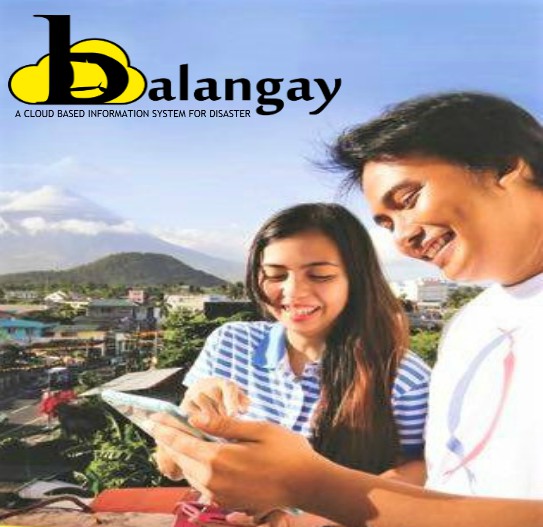Description
The City of Legazpi recognizes the need to sustain its disaster-risk reduction and management (DRRM) initiatives to ensure zero casualties in any type of disaster. Despite efforts to strengthen communication and coordination, there is still an information gap between vulnerable communities and disaster-preparedness information providers.
Balangay is a disaster-preparedness mobile and web application that provides communities information before and during the disaster. It is a public resource that provides to citizens disaster-related information, preparing families for earthquakes, floods and typhoons. It provides a real-time platform for reliable communication between local government units, academy, private sector, civil society organizations (CSOs), non-government organizations (NGOs) and affected communities.
The application’s centerpiece is the use of a custom cloud disaster-information system. End-users can access updates and official disaster-related information for free through a mobile or web application. The application has the following main features:
- Announcement – verified government/institution accounts can post Disaster Risk Reduction and Management (DRRM)-related announcements through the web-based admin console
- Official hazard maps overlay with a global positioning system (GPS) tracking allows users to see susceptibility of their current location to various hazards
- Dictionary and encyclopedia of DRRM terms, survival kit articles and official emergency hotlines
- Hotlines – Directory of DRRM related institutions, information updatable through the admin console.
The application has Facebook integration to maximize information reach and allow free data users to access posts or information without direct access to the application. A custom cache system is in place for mobile users to allow offline access to D-Learning section.
Objectives and beneficiaries
The Balangay aims to create a fast and secure platform for collaboration between the city, academy, private sector and end users, bridging the information gap, and ultimately promoting a collaborative and pro-active approach on Disaster Risk Reduction and Management (DRRM).
The use of mobile and web technology further strengthens the city’s information, education and communication (IEC) strategy for the younger generation, particularly the youth, which is around 40 percent of the total population (196,639 based on 2015 National Census). Through the application, the youth takes the lead role to act as information leaders in the family in the city.
Strong points of the solution
The application is user-centric and there is a heavy emphasis on data collection especially on user preferences. Interviews about what they dislike and why they use/don’t use similar technology-based initiatives were conducted and used in benchmarking.
Official accounts were given to partner institutions. By having institutions post official announcements, members will access the site or application more frequently. By engaging partner institutions, a sense of ownership is developed, resulting in stronger engagement and higher and sustained user-base.
The youth are engaged through local youth hobbyists who are tapped as volunteers to assist and create the promotional materials, and marketed a campaign “from the youth to the youth”. Because the creator of the materials and the flow of activities come from members of the same sector, the target sector was better engaged compared to traditional awareness campaigns.
The local government issued accounts to barangays to let them post announcements and information about their barangay activities. By having Barangay DRRM officials post announcements, their constituents follow Balangay for official information.
Leverage Popular Medium: Social Media and Internet - Aggressive marketing has not been done yet, however, the next phase will include extensive use of social media (Facebook, Twitter, Instagram, etc.) to promote Balangay. Popular advertising schemes will be conducted (like and shared games, snap pics, etc.).
Expected results and benefits for climate change adaptation and mitigation
The Balangay in its test run solidly demonstrated the effectiveness of leveraging popular media and adopting a user-centric approach, which strengthens disaster education, and bridges general information gap.
Statistics of the web and mobile application are very promising since web usage analytics recorded 230 average daily visits in May 2016 to the first quarter of 2017. On the other hand, application downloads from Google Play recorded 300, which exceeded the initial target of 199. As an information dissemination tool, the application provided users rainfall advisory and updates on Tropical Storm Karen in October 2016.
Under the City Mayor’s Office, the city government will roll-out the Balangay by the second half of 2017, in time before the typhoon season. This will be done in collaboration with all village officials. The city government targets to have 10,000 mobile application users before the end of 2017, with a projected increase of 10 to 15 percent per month in 2018.
Scalability potential of the solution
For replication, an LGU needs four basic things:
1. Signify intent to replicate the application in coordination with the City of Legazpi
2. At least one person to attend to technical support issues and monitor their LGU’s cloud server
3. Balangay Technical Training and Cybersecurity best practices training
4. Coordination with LGU’s DRRM office, to get LGU’s hazard-specific materials to include in D-Learning Section
Replication of the system requires the same feedback loop and data sharing (except crucial administrative data for each LGU) among all Balangay systems. The entire project uses the power of crowdsourcing, hence the more data collected, the stronger and more powerful the analytics will be for all LGUs using the system.
[Editor's Note: All information published as submitted by the author(s). Minor edits may have been made to increase readability and understanding.]







